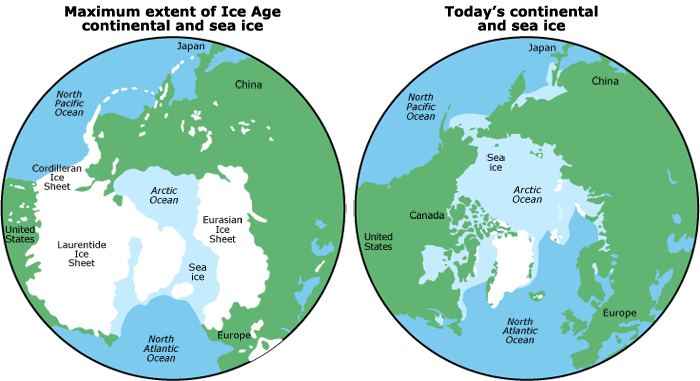Carbon dioxide and the ice age - not the same as the current climate change
Some people think that because the climate has changed before, the current changes must be natural as well.
They also say that CO2 does not change the climate because in the past CO2 has only risen AFTER temperatures rise.
Things are not that simple.
CO2 levels only follow temperatures when glacial stages end.
The 'Ice Age' is actually a long set of colder (glacial) stages and warmer (interglacial) stages.

When the Earth comes out of a glacial stage...
The warming is started by changes in the Earth's orbit.

The warming causes the oceans to release CO2.
The CO2 boosts the warming.
So CO2 causes warming AND those rising temperatures cause CO2 levels to rise.
About 90% of the global warming occurs after the CO2 increase.
In the graph below, the cores mentioned in the key are ice-cores drilled from the ice of Antarctica.
MLO refers to the Mauna Loa Observatory in Hawaii.

It is clear the current rise in the level of carbon dioxide is far bigger than 'natural' changes.
In the graph, the jagged peak around 115,000 to 140,000 years ago is the Eemian Interglacial, when carbon dioxide was fairly high.
Interglacials often have local names - in Britain the Eemian is known as the Ipswichian.
After that, CO2 levels dropped.
The Earth cooled into a long glacial stage, which ended around 12,000 years ago. In the UK that stage is called the Devensian.

Carbon dioxide levels are now rising much faster than normal.

Of course carbon dioxide is only one factor involved in glacial-interglacial stages.
They also say that CO2 does not change the climate because in the past CO2 has only risen AFTER temperatures rise.
Things are not that simple.
CO2 levels only follow temperatures when glacial stages end.
The 'Ice Age' is actually a long set of colder (glacial) stages and warmer (interglacial) stages.

When the Earth comes out of a glacial stage...
The warming is started by changes in the Earth's orbit.
The warming causes the oceans to release CO2.
The CO2 boosts the warming.
So CO2 causes warming AND those rising temperatures cause CO2 levels to rise.
About 90% of the global warming occurs after the CO2 increase.
In the graph below, the cores mentioned in the key are ice-cores drilled from the ice of Antarctica.
MLO refers to the Mauna Loa Observatory in Hawaii.
It is clear the current rise in the level of carbon dioxide is far bigger than 'natural' changes.
In the graph, the jagged peak around 115,000 to 140,000 years ago is the Eemian Interglacial, when carbon dioxide was fairly high.
Interglacials often have local names - in Britain the Eemian is known as the Ipswichian.
After that, CO2 levels dropped.
The Earth cooled into a long glacial stage, which ended around 12,000 years ago. In the UK that stage is called the Devensian.
Carbon dioxide levels are now rising much faster than normal.

Of course carbon dioxide is only one factor involved in glacial-interglacial stages.